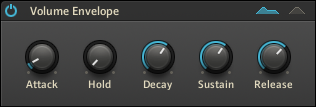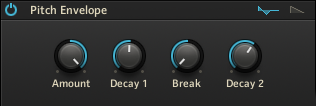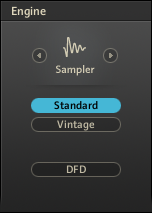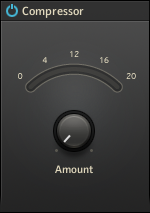Main Page
BATTERY's Main page holds all the basic tools for adjusting the sound of an individual cell within your kit.
The Main page holds the basic tools for adjusting the sound of the individual cells within your Kit; pitch and volume envelope modules, basic filters, a sample engine selection, a one-knob compressor, and send controls for delay and reverb effects can be found here.

The Main page in the Edit area.
Volume Envelope
Apply a volume envelope to the currently active cell from here. When hovering over this module, you can see the envelope shape against the waveform in the Waveform Control (refer to Quick Access Area).
The Volume Envelope module contains the following parameters and controls:

The Volume Envelope module.
Power: Activates/deactivates the envelope.
Envelope mode: The two envelope symbols on the right side of the section header let you choose between two basic types of volume envelope: AHDSR (Attack, Hold, Decay, Sustain, Release), which is represented by the left envelope symbol, and AHD (Attack, Hold, Decay), which is represented by the right envelope symbol. Typically, the AHDSR envelope is for sustained samples, while the AHD envelope is more for “one-shot” sample playback. AHD mode disables the Sustain and Release controls below.
Attack: Adjusts the time it takes for the envelope to reach its maximum level.
Hold: Adjusts how long the envelope will remain at its maximum level. Set this to 10-30ms to add punch to the signal.
Decay: Adjusts the time it takes for the envelope to fall from the hold level to the sustain level.
Sustain: Adjusts the level that will be maintained in the sustain phase as long as the incoming MIDI note is held. Sustain control is not available in AHD mode (see envelope mode selectors description above).
Release: Adjusts the time it takes to return to zero level after receiving a MIDI note-off command (for instance, the MIDI trigger ends). Release control is not available in AHD mode (see envelope mode selectors description above).
Note
In case you selected multiple cells before activating the envelope, the most recently selected cell (with a colored frame) will be displayed in the Waveform Control; however, all selected cells (those with a gray frame) will be affected by the envelope settings.
Pitch Envelope
Apply a pitch envelope to the currently active cell from here. You can see the envelope shape against the waveform in the Waveform Control when hovering over this module.
The Pitch Envelope module contains the following parameters and controls:

The Pitch Envelope module.
Power: Activates/deactivates the envelope.
Envelope mode: The two envelope symbols on the right side of the section header let you choose between two types of pitch envelope: standard mode (with Amount, Decay 1, Break, and Decay 2 controls), which is represented by the left envelope symbol, and easy mode (with only an Amount, and a Decay control), which is represented by the right envelope symbol.
Amount: Sets the degree to which the envelope affects pitch.
Decay 1: Adjusts the time for the envelope to go from its initial level (as set with the Amount control) to the level set with the Break knob.
Break: Adjusts the point where the envelope breaks, for instance, the min/max value from where it moves back towards zero (the pitch can be either higher or lower than the cell's normal pitch).
Decay 2: Adjusts how long it takes for the level set with the Break knob to decay back to zero again.
Note
In case you selected multiple cells before activating the envelope, the most recently selected cell (with a red frame) will be displayed in the Waveform Control; however, all selected cells (those with a gray frame) will be affected by the envelope settings.
Velocity
Lets you adjust how much the input velocity will affect the volume and pitch of triggered cells.
The Velocity module contains the following parameters and controls:

The Velocity module.
To Volume: Adjusts how input velocity will affect the volume of triggered cells. When set to 0 %, velocity will not affect the volume of the triggered cell, for instance., no matter how hard you hit the key or pad, the output volume will always be 100% of the cell's volume setting. Turning the knob all the way to the right will translate the input velocity to a percentage of the cell’s volume level (with an underlying minimum value of -inf dB).
To Pitch: Adjusts how input velocity will affect the pitch of triggered cells. When set to 0 st., velocity will not affect the pitch of the triggered cell, for instance, no matter how hard you hit the key or pad, the cell will always play at its original pitch. Turning the knob to the right will translate the input velocity to semitones (with an underlying minimum value of 0 st., and a maximum value of +12 st.)
Engine
The engine module allows you to select between two basic sampler engine modes: Sampler mode and Stretch mode. The former has an additional submode that emulates the sound of two legendary hardware samplers. An additional mode, Beat mode, is available for samples containing timing information, such as REX files, ACID wav files, and Apple Loop files.
The Engine module contains the following parameters and controls:

The Engine module.
Sampler: In Sampler mode, BATTERY stores sample data in the system memory, reads it out from memory, and applies any needed pitch-shifting by re-sampling the audio data.
Standard: Activates BATTERY's standard sampler engine.
Vintage: Activates vintage interpolation modes, which emulate the sonic characteristics of two legendary samplers often used in Hip Hop and electronic music. With Vintage mode active, you can select one of the sampler emulations from the drop-down menu below.
DFD: Streams samples Direct From Disk instead of RAM. This is important if you have large samples but limited RAM.
Stretch: In Stretch mode, BATTERY uses granular synthesis to alter sample speed while preserving the original pitch information.
Standard: Activates BATTERY's standard stretch engine. It contains the following parameters:
Grain: Adjusts the size of the sound particles used for resynthesis.
Speed: Changes the playback rate independently of pitch. The length values are expressed as a percentage of the original length: for example, 100% plays back the sound at the original speed, 200% doubles the speed, 50% halves the speed, etc.
Smooth: Adjusts the number of granular micro-envelopes to reduce unwanted artifacts, thus altering the sonic character of the resynthesis process. Note that small values generally cause a buzzier sound.
Pro: Activates BATTERY's Pro stretch engine.
Speed: Changes the playback rate independently of pitch. The length values are expressed as a percentage of the original length: for example, 100% plays back the sound at the original speed, 200% doubles the speed, 50% halves the speed, etc.
Beat: Sets options for Beat mode. When you load a sample containing timing information (such as a REX file, an ACID wav file, or an Apple Loop file) into a cell in BATTERY, the Engine module will automatically be set to Beat mode. The individual slices of the sample will playback at the speed determined by the module's controls, or synchronized to BATTERY's internal clock (or that of your host application), depending on the module's settings in its Sync menu. It contains the following parameters:
Expand: Expands the individual slices of the sample to individual cells in BATTERY, starting with the next empty cell. In BATTERY's preferences (refer to Loading), there is also a setting to make this the default behavior.
Sync: Adjusts the sync mode between BATTERY and your DAW. Selecting Sync Off uncouples the sample from BATTERY's internal tempo or that of your host software. Selecting one of the note values synchronizes the sample's slices to the beats of BATTERY's internal clock (or that of your host software).
Speed: Alters the sample’s playback speed without altering its pitch.
Smooth: Adjusts the attack and release of the individual slices to prevent clicks.
Filter
A simple high-pass/low-pass filter to be applied to the selected cells.
The Filter module contains the following parameters and controls:

The Filter module.
Power: Activates/deactivates the filter.
High Cut: Sets the frequency above which the signal will be attenuated.
Low Cut: Sets the frequency below which the signal will be attenuated.
Compressor
A one-knob control feedback compressor to smooth out the audio signal.
The Compressor module contains the following parameters and controls:

The Compressor module.
Power: Activates/deactivates the module.
VU meter: Displays the amount of gain reduction in real-time.
Amount: Adjusts the amount of compression.
Sends
Contains two knobs that control the amount of the signal to be sent to the delay and reverb units in the Master page (refer to Master Page).
The Sends module contains the following parameters and controls:

The Sends module.
Delay: Determines the amount of signal to be sent to the Delay module on the Master page.
Reverb: Determines the amount of signal to be sent to the Reverb module on the Master page.
Note
Refer to Master Page for instructions on adjusting the delay and the reverb module.